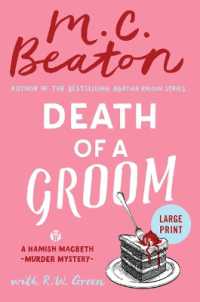Full Description
A comprehensive account of music in Florence from the late Middle Ages until the end of the Medici dynasty in the mid-eighteenth century.
Florence is justly celebrated as one of the world's most important cities. It enjoys mythic status and occupies an enviable place in the historical imagination. But its musico-historical importance is not as well understood as it should be. If Florence was the city of Dante, Michelangelo, and Galileo, it was also the birthplace of the madrigal, opera, and the piano. Music in Golden-Age Florence, 1250-1750 recounts Florence's principal contributions to music and the history of how music was heard and cultivated in the city, from civic and religious institutions to private patronage and the academies. This book is an invaluable complement to studies of the art, literature, and political thought of the late-medieval and early-modern eras and the quasi-legendary figures in the Florentine cultural pantheon.
Contents
Preface
Book the First
Music in Late-Medieval Florence: The Duecento and Trecento
Music and the Ecclesiastical and Political Organization of the Late-Medieval City
The Duecento
1 * Church and State in Florence circa 1300
Santa Reparata/Santa Maria del Fiore
Palazzo della Signoria
Music at Santa Reparata/Santa Maria del Fiore
The Duecento Lauda
Instrumentalists of the Signoria
The Trecento
2 * Secular Polyphony: The Beginnings of the Florentine Tradition
The Social Context of Performance
Johannes de Florentia (fl. ca. 1351)
3 * Secular Polyphony: Francesco Landino and the Central Florentine Tradition
Ser Gherardellus de Florentia (†1362 or 1363)
Donatus de Florentia and Laurentius Masii de Florentia (†1372)
Francesco Landino (†1397)
4 * Secular Polyphony: The Gallicization of Florentine Musical Culture
Some Florentine Kleinmeistern: Magister frater Egidius, Magister Guglielmus frater, and Corradus
Andreas de Florentia (Andrea di Giovanni) (†1415)
Some Florentine Kleinmeistern Redux: Bonaiutus Corsini and Andrea Stefani
Paulus de Florentia (†1436)
5 * Music in Communal Worship and Civic Life
Liturgical Polyphony
The Trecento Lauda
The Herald of the Signoria
Book the Second
Music in Renaissance Florence I: The Quattrocento
Aristocracy Emulated: The De Facto Medici Regime
6 * The Medici Regime and the Public Ecclesiastical Institutions
Nicolaus Zacharie and the Professionalization of Composing and Performing
The Consecration of the Cathedral of Florence
The Musical Establishments Stabilized
Heinrich Isaac
7 * Tradition and Innovation in Sacred Music
Tradition: Music for the Liturgy
Tradition and Innovation: The Quattrocento Lauda
Innovation: The Sacra Rappresentatione
8 * Heralds, Knights, and Carnival Revelers
Tellers of Tales
Medieval Chivalric Tradition Reimagined
Florentine Carnival and the Canto Carnascialesco
9 * Music and Domestic Life: The House of Medici
Occasions for Music-Making
The Patrons, Their Musicians, and Their Music
The Musical Sources
Varieties of Music-Making
10 * Girolamo Savonarola and the Medici in Exile
Theocratic Censure
The Medici in Exile, 1494-1512
Book the Third
Music in Renaissance Florence II: The Cinquecento
Aristocracy Achieved: The De Jure Medici Regime, Family as Country, and "Florentinism"
11 * The Medici Restoration: The Florentine-Papal Tandem
The Restoration
Composers in Medici Service
Music in Private Medici Settings: Instrumental Music
12 * A New Institution, a New Technology, a New Genre: The Madrigal
Wellsprings of the Madrigal: The Chanson
Wellsprings of the Madrigal: The Canto Carnascialesco and Trionfo, the Lauda, and Solo Song
The Earliest Madrigals
Florentine Academies and Madrigals for the Theater at Midcentury
Intimate Settings: Isabella de' Medici, Solo Song, and the Polyphonic Madrigal
Intimate Settings: The Florentine Madrigal after Midcentury
13 * The Church
The Reconstitution of the Polyphonic Chapels
The Reformation and Counter-Reformation
The Cinquecento Lauda and Sacra Rappresentatione
Intermedi Sacri e Morali and Music in Religious Communities for Women
14 * Medici Pageantry, 1539-1589: "L'état, c'est moi"
Book the Fourth
Music in Florence in the Baroque Era
Cross-Genre Influences: Monody, the Stile Recitativo, and the Stile Concertato in Florentine Music of the Seicento and Early Settecento
15 * Opera in Florence, Act 1: The Florentine Aristocratic Phase
Academic Theories Applied
The Beginnings of Opera
Widening Applications of the Innovations
The Meaning of Baroque
16 * Intermedio I: Music in Religious and Dynastic Ritual
Religious Ritual: A Cappella and Concerted Vocal Music
Religious Ritual: Music for Organ
Dynastic Ritual ("L'état, c'est moi"): The Equestrian Ballet
17 * Opera in Florence, Act 2: The Pan-Italian Phase
A New Institution: The Opera House
Beginnings of the Pan-Italian Phase: La finta pazza
A Native Attempt at a Venetian-Style Opera: Celio
Venetian Imports: Ipermestra
A Distinctively Florentine Tradition of Comic Opera: Il potestà di Colognole
Venetian Imports: Ipermestra, Redux
The Baroque Aesthetic on Full Display: Ercole in Tebe, L'Orontea, La Dori
18 * Intermedio II: Devotional and Convivial Uses of Music
Devotional: The Lauda Reimagined: Canzonette Spirituali
Devotional: The Oratorio
Convivial: Ballet Entertainments
Convivial: The Seicento Madrigal
Convivial: The Seicento Cantata
Convivial: Instrumental Genres
Convivial: The Invention of the Piano
19 * Opera in Florence, Act 3: The Pan-European Phase
Opera in Arcadia? The Halting Adoption of Reform Principles—Griselda
Grand Prince Ferdinando and a Restitution of Aristocratic Opera
The Reopening of Teatro della Pergola
Vincer se stesso è la maggior vittoria, or Rodrigo
Opera in Arcadia: The Fuller Adoption of Reform Principles—Catone in Utica
The Settecento Cantata
Conclusion
Acknowledgments
Notes
Bibliography
Index
Color illustrations follow page 000.







